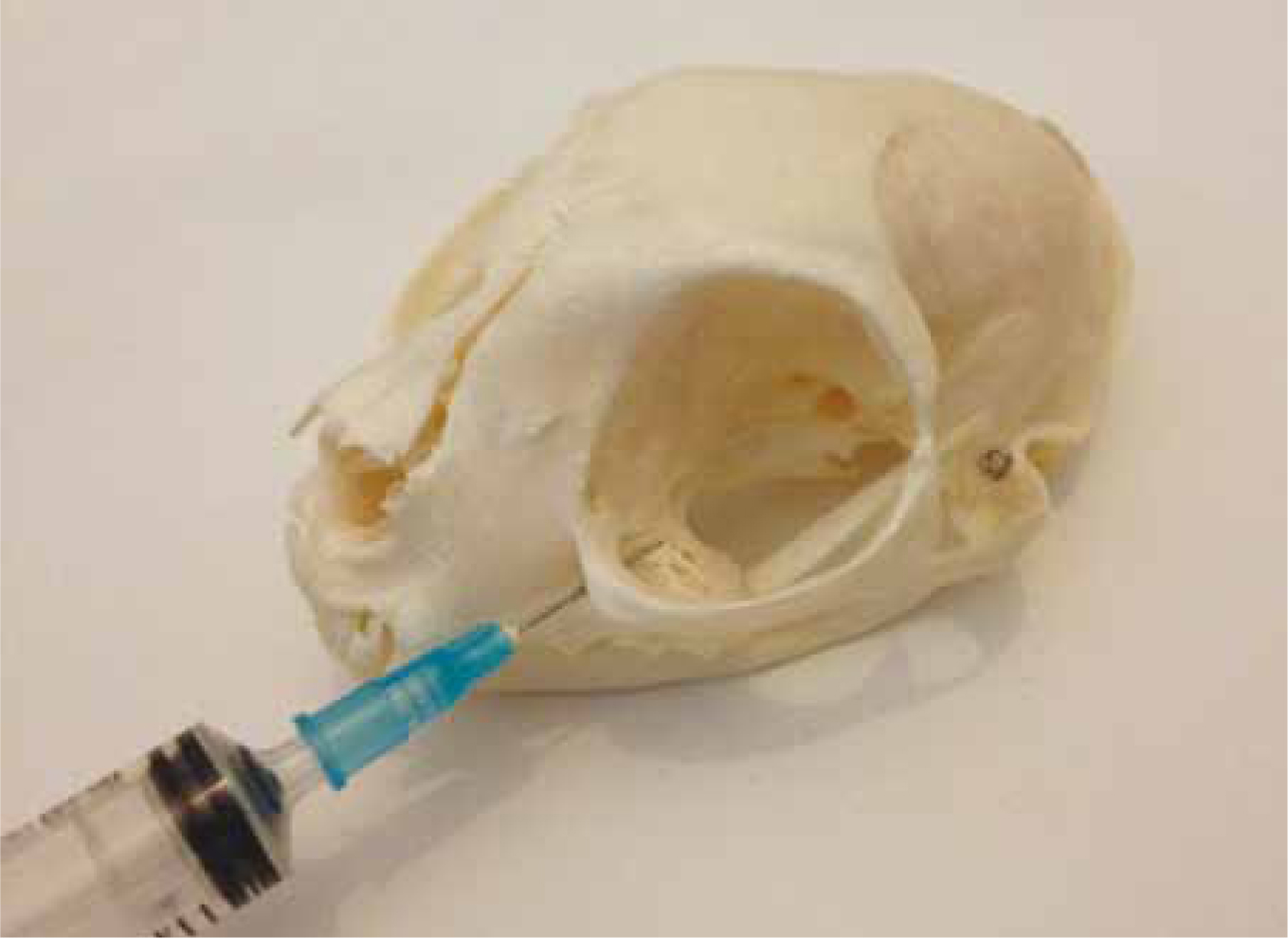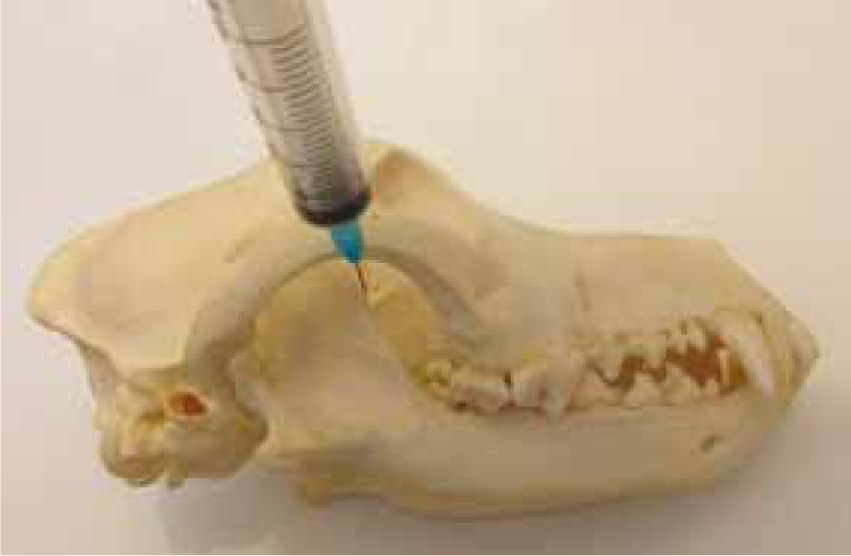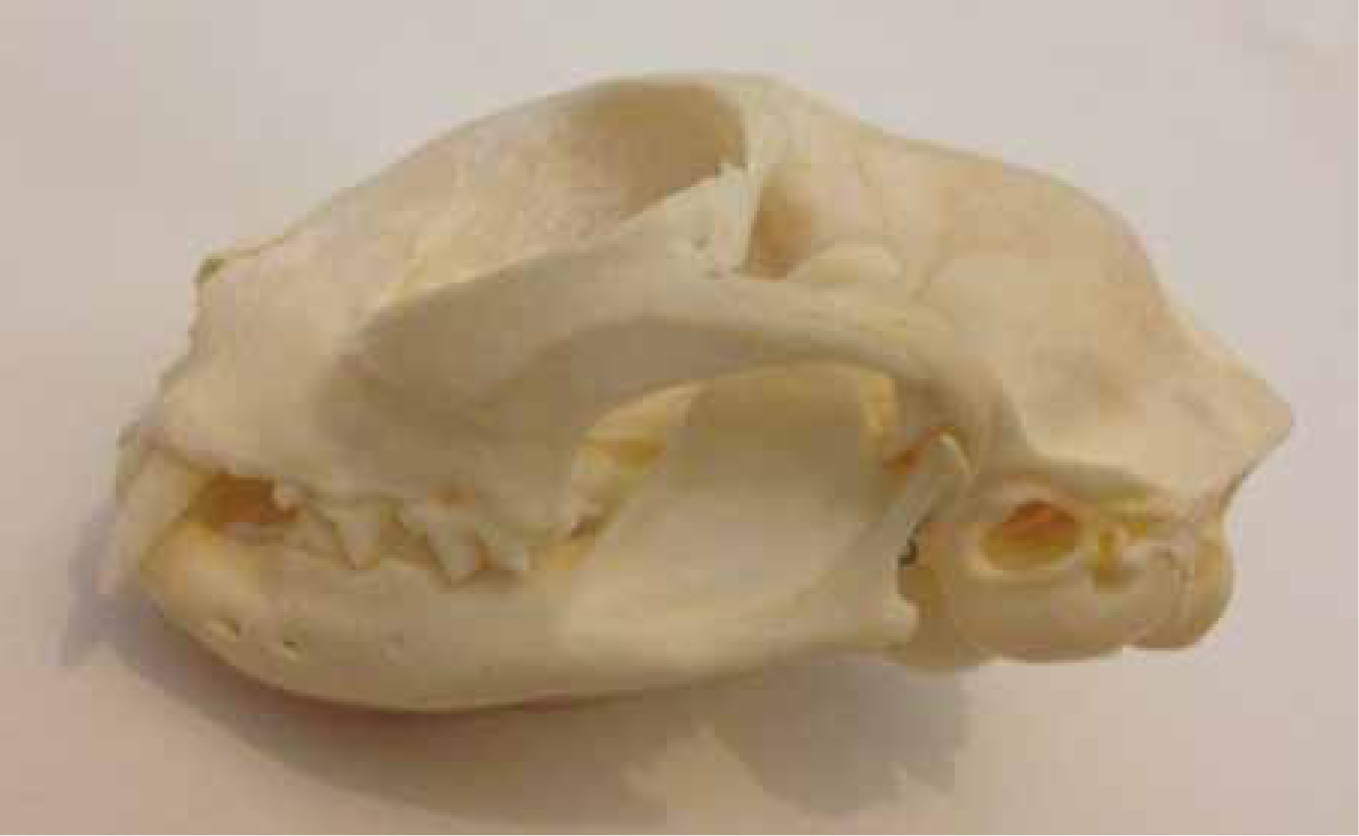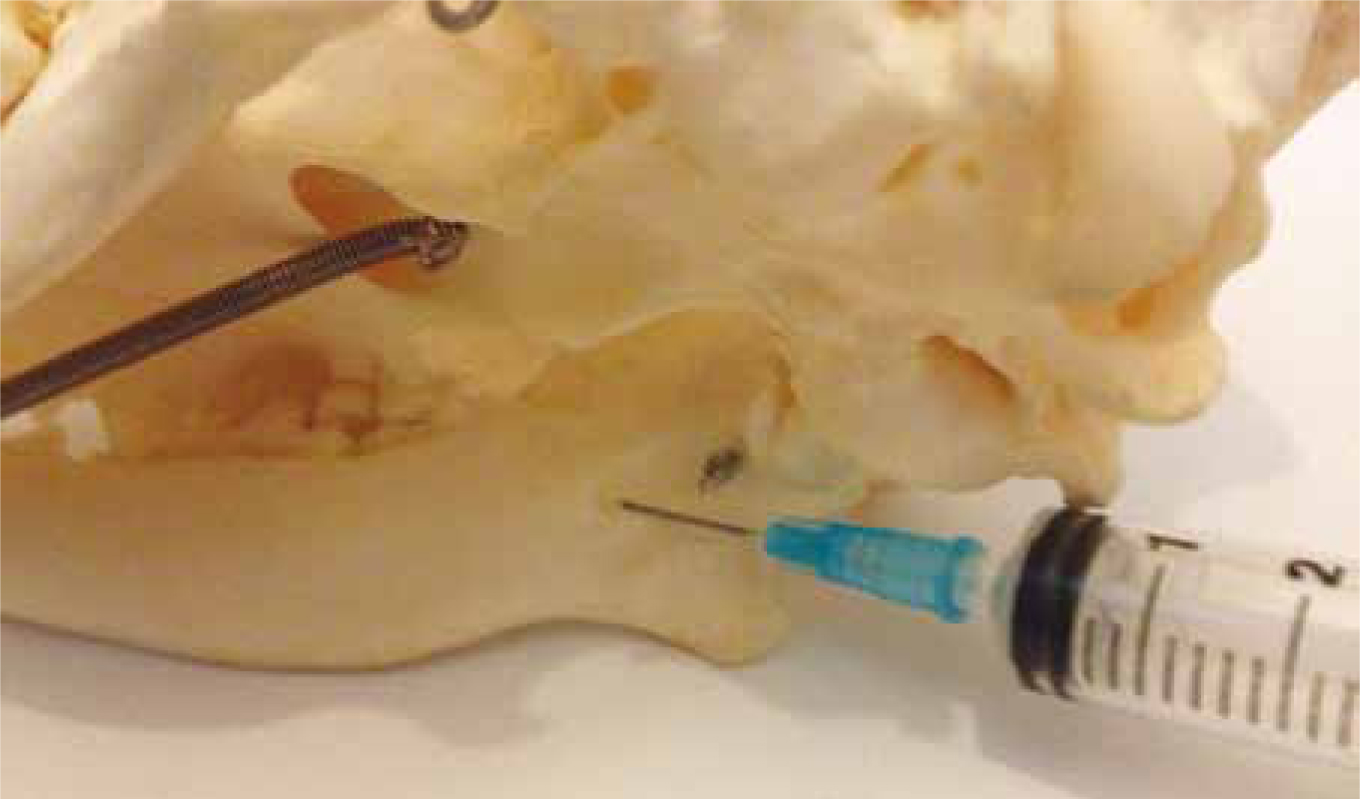A balanced anaesthesia plan should be designed for all patients, including dental patients, and those requiring faciomaxillary surgery, e.g. mandibulectomy. This should include pre-emptive, intra-operative and post-operative analgesics. Local anaesthesia techniques are being increasingly used in anaesthetic and pain management plans for dental patients and comprise techniques which are relatively simple to perform. Local anaesthesia can be defined as a temporary loss of sensation in a specific, limited area of the body without loss of consciousness (Reuss-Lamky, 2007). The use of local anaesthetics should be considered for all surgical procedures as they provide the only true analgesia, where as all other analgesic agents in fact ‘reduce’ pain.
Lidocaine and bupivacaine can be mixed with epinephrine to produce localised vasoconstriction (local anaesthetics will cause vasodilation which increases bleeding and shortens their duration of action at the site). This serves to delay the absorption of the drug and prolongs the duration of action, however this is not commonly performed in veterinary local blocks and is contraindicated in certain patients, e.g. cardiac patients.
There are a variety of drugs available to veterinary professionals to address pain at each point along the nociceptive pathway. Providing such therapy to attack pain from different angles is known as multimodal analgesia and should be the goal of any pain management plan. Local anaesthesia techniques play a key role in providing multimodal analgesia by inhibiting transduction, inhibiting transmission, and modulating spinal pathways (Gaynor and Muir, 2009). If the transmission of painful impulses to the spinal cord is prevented patients are not only more comfortable, but it may be easier to provide analgesia later as wind up may have been prevented. Wind up is the collective term commonly given to exaggerated responses to noxious stimuli, i.e. hyperalgesia, a heightened sense of pain at the site of injury or in surrounding undamaged tissue, and allodynia, activation of ‘silent’ nociceptors resulting in the body interpreting a normally non painful stimulus as painful. The effect of this multimodal analgesia approach is smoother anaesthetics, with generally less volatile agent settings being required, and this will decrease the side effects associated with volatile agent administration, e.g. hypotension (Grint, 2011).
Both lidocaine and bupivacaine are widely used for local and regional blocks in small animals. Lidocaine has a rapid onset (5–10 minutes) and relatively short duration, about 60–120 minutes. Bupivacaine has a slow onset, about 10–20 minutes, but a long duration, about 3–6 hours. The combination allows for a rapid onset and long duration of blockade. Both can be administered at 1.5 mg/kg alone or together for a block. Bupivacaine can be cardiotoxic if administered intravenously (IV), so it is critical that you aspirate (to ensure the needle is not located in a blood vessel) prior to injecting bupivacaine into tissues.
Local anaesthetics work by causing blockade of sodium channels in the cell membrane of neurons, stopping conduction of nervous impulses along the nerve until the drug is absorbed into the local circulation. All nerve fibers are susceptible to blockade but the size of the nerve fibre and the presence or absence of myelination will determine how sensitive a particular nerve fibre is to the local anaesthetic. Although differential blockade exists among the nerve fibres, the local anaesthetics tend to block the sensory pain receptors (nociceptors) first, followed by blockade of the thermoreceptors, mechanoreceptors (touch, deep pressure) and last motor fibers. This means that the small, unmyelinated C fibers that mediate nociception can be effectively blocked while motor innervation to the muscles is maintained. This means function and movement of that part of the area is maintained. The uptake of a particular local anaesthetic, their affinity for the receptor sites and their lipid solubility will also play a role in determining the degree of blockade.
All staff performing any type of local block should be aware of the toxic side effects of local anaesthetics. Central nervous system (CNS) toxicity is seen at much lower doses than those required to produce cardiovascular toxicity. Signs of CNS toxicity include muscle twitching and seizures. To prevent the risk of toxicity, total doses of local anaesthetic should be calculated carefully and based on the patient's lean bodyweight, this should also include any local anaesthetics used to desensitise the larynx. Care should also be taken when performing bilateral local blocks, particularly mandibular blocks, as this can cause desensitisation of the patient's tongue (blocking of the lingual nerve), and result in self trauma.
A number of local and regional blocks are easy and inexpensive to perform. Cost is further reduced if a qualified veterinary nurse is trained and allowed to perform the blocks, freeing up the veterinary surgeon. Local techniques that can easily be implemented in general or speciality practice are described below and the suggested dental nerve block drugs, dosages and toxic doses are listed in Table 1. If additional volume is required, dilute up to 1:1 with sterile saline. All blocks described here are performed after appropriate clipping and prepping, following sterile technique principles.
| Lidocaine 2% | Bupivicaine 0.5% | |
|---|---|---|
| Canine | 5 mg/kg | 2 mg/kg |
| Feline | 2.5 mg/kg | 1 mg/kg |
| Onset (minutes) | 10 | 20 |
| Duration (hours) | 1–2 | 3–6 |
| Toxic dose | 6–8 mg/kg (dog) |
3–4 mg/kg (dog) |
* NB. Cats have a lower threshold for drug toxicities, therefore lidocaine should be used cautiously to ensure overdose does not occur
Dental nerve blocks
A number of techniques exist to block various parts of the head and muzzle. These blocks are particularly useful in those patients undergoing painful dental procedures, mandibulectomies, maxillectomies, and soft tissue mass removals on the lips and gums. An infraorbital block desensitises the upper lip, nose, roof of the nasal cavity, and skin as far caudal as the infraorbital foramen. A maxillary nerve block will provide complete blockade of the entire hemimaxilla, including the teeth. A mental nerve block anaesthetises the lower incisors and skin and tissues rostral to the mental foramen. Finally, a mandibular nerve block anaesthetises the entire hemimandible and more reliably anaesthetises the teeth of the lower jaw.
Infraorbital nerve block
The infraorbital nerve has multiple sensory branches that innervate the nasal and buccal soft tissues as well as the incisor, canine, and premolar teeth. In dogs, the foramen is located on the maxilla, dorsal to the caudal (distal) root of the third maxillary premolar. The caudal extent of the infraorbital canal is located at the level of the medial canthus of the eye, which can serve as a guide for maximum needle advancement. Caution must be exercised when performing this technique on cats and brachycephalic dogs. Because the infraorbital canal is short, when compared with that of normocephalic and dolichocephalic dogs, the medial canthus is generally used as a guide to the limit of how far the block should be placed (Woodward, 2004). The approach to the infraorbital block can use either a cranial or caudal technique.
The cranial infraorbital nerve block desensitises the incisor, canine, and premolar teeth rostral to the fourth premolar as well as the associated ipsilateral soft tissues. This block is performed at the opening of the infraorbital foramen, which can be accessed either intraorally or extraorally, using a percutaneous approach (Figure 1a and b). The needle should not be inserted deeply into the infraorbital canal, and injection of only a small amount of local anaesthetic (usually 0.25–0.5 ml) is necessary (Reuss-Lamky, 2007). Some authors believe that after the local anaesthetic has been injected, applying pressure over the injection site for 60 seconds while elevating the head will further encourage caudal diffusion of the local anaesthetic agent (Reuss-Lamky, 2007).


The caudal infraorbital nerve block desensitises the same areas desensitised by the cranial infraorbital block, plus all of the bone, soft tissue, and dentition rostral to the maxillary first molar. The area affected by this block depends on the degree of caudal diffusion of the anaesthetic agent. Unless the agent diffuses beyond the caudal borders of the infraorbital canal, adequate analgesia cannot be provided to the maxillary fourth premolars and molars. Therefore, if anaesthesia to the caudal cheek teeth is required, it is recommended that the maxillary nerve block be performed. The caudal infraorbital nerve block is administered similarly to the cranial infraorbital nerve block except that the head is kept elevated and once the needle is in place, following aspiration, gentle pressure is applied as the solution is injected. It is recommended by the author that gentle pressure is maintained over the injection site during the procedure and for 30–60 seconds after withdrawing the needle. This technique, combined with the head elevation, further encourages caudal flow of the agent deep into the infraorbital canal and regional tissues (Gracis, 2013). An additional 50% of the calculated volume of local anaesthetic can be administered for the caudal infraorbital nerve block to encourage adequate diffusion to the middle superior alveolar nerves that lie within the infraorbital canal (Reuss-Lamky, 2007). In cats, the infraorbital foramen is located above the maxillary second premolar and is within the junction of the zygomatic arch and maxillary bone. The infraorbital canal is only about 4 mm long in a mature cat and ends at the level of the medial canthus. A 27-gauge needle attached to a syringe containing the calculated local anaesthetic dose is inserted into the foramen and advanced into the infraorbital canal, aiming ventrally at a 45o angle for a maximum of 2–3 mm. Again maintain pressure over the site for up to 60 seconds post injection. Caution must be taken in cats because if the syringe is not kept with the correct dorsoventral angle, it is possible to direct the needle in any direction, and risk injuring the globe (Gracis, 2013) (Figure 1c).

Maxillary nerve block
The maxillary nerve block affects all of the bone of the maxilla, the soft and hard palates, the soft tissue of the nose and upper lip, and dentition rostral to the maxillary second molar (i.e. the entire hemimaxilla) (Reuss-Lamky, 2007). In dogs, the maxillary nerve block is performed intraorally by inserting the needle just caudal and central to the last maxillary molar. Palpate the space between the most ventral border of the zygomatic arch and the caudal border of the maxilla. Insert the needle where the ventral portion of the zygomatic arch joins with the maxilla (Figure 2a and b). This should place the tip of the needle at the caudal entrance of the infraorbital foramen (Gracis, 2013). The needle can be placed perpendicular to the skin or at a slight angle with the needle tip pointing rostrally. Advance the needle dorsally to a level just beyond the root tips of the last molar, and then aspirate and slowly inject the agent. The maxillary nerve block is preferred over the infraorbital nerve block for providing analgesia to the maxillary molars (Reuss-Lamky, 2007). This block is indicated for tooth extraction, maxillectomy, tumor removal and possibly rhinoscopy.


Mental nerve block
Blocking the mental branch of the mandibular nerve as it exits the largest and most rostral of the mental foramina anaesthetises the lower incisors and skin and tissues rostral to the foramen (Gaynor and Mama, 2002; Lemke, 2007). The location of the middle mental foramen varies with the breed, size, and species of the patient. Easily palpable in larger dogs, the foramen can be hard to palpate in smaller dogs, which makes the middle mental block more difficult to perform in smaller patients (Reuss-Lamky, 2007). In dogs, the middle mental foramen is located ventral to the rostral root of the second premolars (Figure 3a and 3b). If the area cannot be palpated, place the needle in the submucosa at the ventral third of the mandible at the level of the diastema between the first and second mandibular premolars. Place a finger over the needle during the injection to help direct the anaesthetic into the foramen (Gracis, 2013). The agent should be injected very slowly. Digital pressure should be maintained over the injection site for 60 seconds following injection to ensure maximum caudal diffusion of the agent into the foramen (Legendre and Beckman, 2002). In cats the middle mental foramen is very small (Figure 3c) and difficult to locate. In cats, this block is performed as described for the dog, but use of a 27-gauge needle may allow easier access into smaller feline foramina. Because the middle mental nerve block provides limited analgesia to only a small section of the mandible, the mandibular nerve block may be a more practical alternative for use in cats (Reuss-Lamky, 2007).



Mandibular (inferior alveolar) nerve block
Blocking the inferior alveolar branch of the mandibular nerve at its point of entry into the mandibular canal at the mandibular foramen anaesthetises the entire hemimandible and more reliably anaesthetises the teeth of the lower jaw (Gaynor and Mama, 2002; Lemke, 2007). Insert the needle percutaneously or intro-orally at the ventral angle of the mandible, slightly rostral to the angular process, and advance it dorsally, against the medial surface of the ramus, to the palpable lip of the mandibular foramen. The bevel of the needle should be directed towards the bony surface. After test aspiration, apply digital pressure during injection to facilitate movement of the drug into the foramen. Entry into the foramen is unlikely but palpation of the needle tip during the procedure can result in more precise direction of local anaesthetic to a location over the foramen (Gracis, 2013) (Figure 4a and 4b). In humans bilateral mandibular blocks are discouraged due to the risk of lingual anaesthesia resulting in self-inflicted injuries by the patient as they may be unable to feel the tongue, or swallow for a period of time following the procedure (Malamed, 2004).


Splash blocks
Another technique which may be utilised during oral surgery is a splash block, whereby local anaesthetic is placed directly into a surgical site, e.g. extraction pocket, or injected into a closed space, where the agent will diffuse (Reuss-Lamky, 2007).
Conclusion
Local anaesthetic techniques are the only true analgesics, whereby all pain sensations are blocked, rather than being reduced (hypoalgesics). When creating an analgesic plan for any surgical procedure, the incorporation of a local anaesthetic technique into that plan should be considered whenever possible. Used in conjunction with general anaesthesia, the anaesthetics on these patients are generally smoother, with lower volatile agent settings being required, this in turn is beneficial in reducing the negative effects of these agents, e.g. hypotension, hopefully resulting in a safer anaesthetic for the patient.

